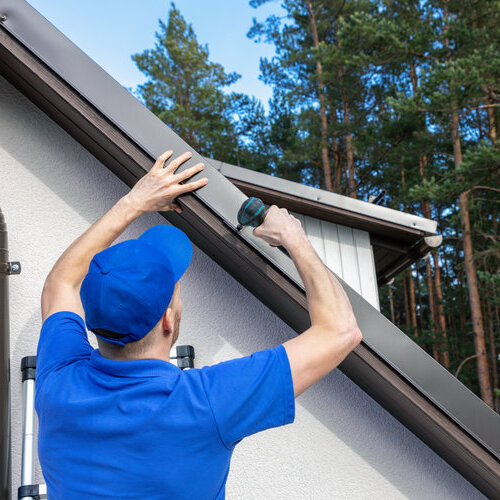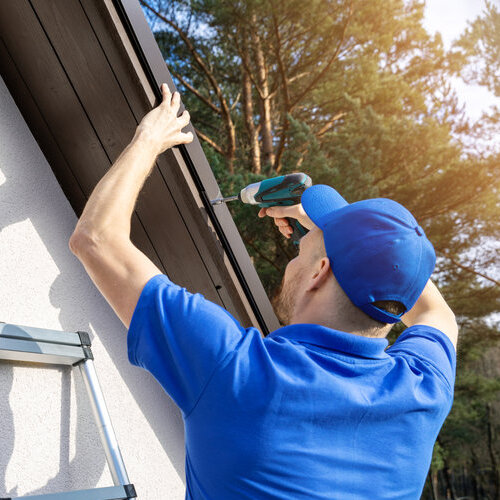
Identifying Roofing Components
A roof has many components to it besides the shingles that we see. There are rafters, decking, underlayment, fascia, soffits, shingles, gutters, and the drip edge. Each of these has an important function in the health of the roof, which is an important component to your home as a whole. Today, we’re going to discuss the importance of the drip edge for roofing.
Many homeowners getting a new roof installed will ask, “Is a drip edge required even if we have gutters installed too?” when they see it itemized on estimates. The answer is yes, the drip edge is required if you want investment in a new roof that outlasts the time spent paying it off.
The next part of that question is, if gutters are installed, why use a drip edge too? Aren’t they doing the same job? A drip edge and gutters have different shapes, they’re installed differently, and they have different jobs and purposes. Both are an important part of your roof and if both aren’t installed correctly, or one is left off, your roof is at risk.
The drip edge and the gutter system keep the roof secure as they filter and redirect water from the attic and away from the foundation of your home. While they may serve the same goal, they are different.
Drip Edge Advantages
Let’s discuss drip edge vs gutter, the advantages that both provide a roof, and why a house should have a drip edge with gutters. Here are some of the advantages you can expect from a drip edge.
- Guards the Fascia: Without the fascia, the roofline is exposed to rain that can cause extreme damage with roof dripping, discoloration, and rot. The drip edge sends the water flow to the gutter.
- Rain and Wind Protection: During a storm, the wind will push the water to the roof corners and gaps, and it’s here that gravity takes over. Without a drip edge, the wind will push the water back up on the roof instead of it being directed to the gutter.
- Insect Protection: The drip edge covers up the space between the roof decking and the fascia board. Without that big gap being overhead, critters and insects will have easy entry into your home and can get deep inside the wood cavity.
- Fascia Board Protection: The drip edge will also direct water away from the fascia to the gutter and keeps water from dripping to the ground under the fascia board. If your home has a basement, the drip edge will keep water from penetrating the ground at the basement and leaking into the basement.
- Attic Stabilization: Roof damage is often caused from instability that heavy winds, ice dams, moisture, and rainwater can cause. A drip edge provides that stabilization by preventing formation of ice dams and prevents water from getting into gaps.
Gutter Advantages
Gutters have plenty of advantages as well. Here are some things having a gutter system can do for you.
- Strong Protection: A drip edge will prevent the attic from being damaged in heavy rains that would otherwise be directed into a gutter. This secures the roof deck, fascia, and gaps, and fascia as water will not go down there. Gutter aprons are made up of galvanized material that tends to flow all the water smoothly into the gutter.
- Infestation Prevention: A gutter will provide protection against small critters setting up residence in your attic by covering the gap into the attic.
- Minimize Maintenance: A gutter system will minimize maintenance needed by catching the rain so that it can’t penetrate into the attic and under the shingles.
When does a drip edge go on?
In 2012, the drip edge became mandatory on the IBS (International Building Codes). For a house with shingle roofing and a wooden attic, the drip edge provides a strong level of protection. It filters out the water from the roof and directs it away from the fascia and into the gutter.
Drip edges are referred to as D-Metal, are usually in a ‘T’ shape, and are installed along the edge of the roof at the eaves, on the rakes after the underlayment is installed.
How much drip edge do I need?
To calculate the amount of drip edge, the metal strip that is installed under the underlayment, measure the length of the roof all the way around and then add 10% to that amount.
How to make drip edge corners?
Overlap drip edge sections by one inch on the straight edges, overlapping in the direction of the normal winds. With overlapping on rake edges from bottom to top, ensuring both sides are flush. Start at the corner and nail every two feet, mitering the corners with tin snips. Cut the angles at about 45 degrees, with the mitered ends overlapped, not flush. The corners should be overlapped with a piece of drip edge square on the two edges against the roof end.

Curiosity May Kill The Roof
What happens when you have a drip edge without fascia? Without a drip edge, the water clings to the shingles and will work up and under the shingles. This will create rot and eventually a leak. One of the key jobs of fascia is to cap the rafter edges. It also holds the gutters in place, all a part of proper water drainage that protects the roof, siding, foundation, and landscaping. If you need help with a drip edge in Canton, GA our team at Affordable Gutters Plus LLC can help when you give us a call at 770-735-4433.
